Category Archives: Uncategorized

Tip of the Week: Waterchanges
I’m the type of hobbyist that likes to keep things as simple as possible while maintaining the best possible water quality that I can. One of the more important parts of this is completing weekly water changes. I have found that completing a weekly water change of about 10% to 20% works well for maintaining trace element that will be consumed by corals and coralline algae while helping to prevent a buildup of nitrates and/or phosphates in the water. Depending on the amount and type of corals combined with the bioload of your fish, you can adjust the amount of your water change to have the same effect. I have found the less supplements you have to dose, the more stable your water will be. Weekly water changes allow me to achieve that without having to put a lot of effort and expense into dosing and testing trace elements.
The below links can add a little more details for you
https://www.reefaquarium.com/2012/mixing-saltwater/
https://www.reefaquarium.com/2013/the-basics-of-marine-aquarium-water-parameters/
http://reefkeeping.com/issues/2007-11/nftt/
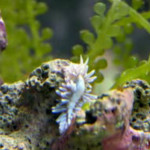
Berghia (Aeolidiella) Nudibranch – Natural Aiptasia Control
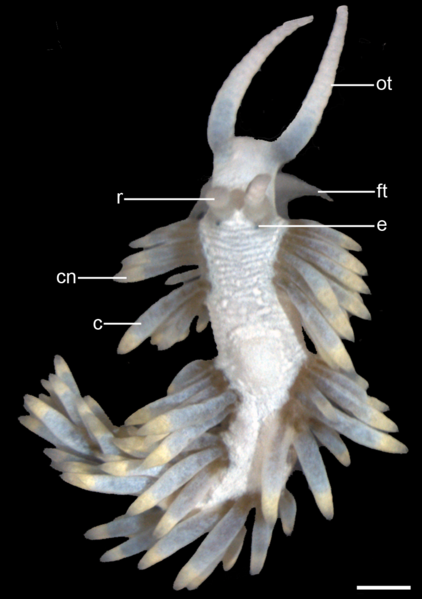
Aeolidiella stephanieae
ot = oral tentacles,
ft = foot tentacles
e = eye,
r = rhinophores,
cn =cnidosacs at the cerata tips.
c = cerata.
Picture by: Alen Kristof & Annette Klussmann-Kolb
Aiptasia can be a big problem in a reef tank and there are plenty of different methods available for getting rid of Aiptasia ranging from chemical products to spot application with lemon juice. Click to learn more about Aiptasia and how to get rid of Aiptasia. In this article we are going to focus on the Berghia nudibranch and how it can be used to exterminate Aiptasia from your reef.
Berghia (Aeolidiella) Nudibranch
The Berghia nudibranch is a small nudibranch that is commonly kept in aquariums to control Aiptasia, a type of pest anemone. In is the most commonly kept and sold sea slug in America. Almost all sold specimens are bred in captivity.
The Berghia nudibranch grows to be no more than 20 mm in length and has a soft sensitive body. This species should not be handled more than necessary since it is very easy to harm these fragile creatures.
The Berghia nudibranch kept in aquariums is native to waters around Southern Florida and the Florida keys where it is found in shallow water. It is only one of many species of Nudibranches that eat Aiptasia. It is however the only species of Aiptasia eating sea slug common in the aquarium trade.
Aeolidiella stephanieae not Berghia verrucicornis
The Berghia nudibranch is called the Berghia Nudibranch because it was believed that the Sea slugs kept in aquariums belonged to the species Berghia verrucicornis. This is however not the case. The species commonly kept in aquariums as the Bergia nudibranch or the Berghia sea slug is actually Aeolidiella stephanieae, another species belonging to the same family (but another genus). Aeolidiella stephanieae was described by science in 2005 (Valdés A. (2005). “A new species of Aeolidiella Bergh) . The Berghia nudibranch should in other words more correctly be called the Aeolidiella nudibranch. The common name Berghia nudibranch have however stuck in the trade due to the fact that it had been used for a long time before the sea slug was re-categorized as a new species.
It is not unlikely that it in time will be discovered that there actually is several similar looking species of Berghia nudibranches kept in aquariums to control Aiptasi. I am basing this statement on differences described from observations of the life cycle and reproduction of different nudibranch populations kept in aquariums. Another factor that suggest that there might be several species kept in the aquarium trade is that Aeolidiella stephaniea is said to reach a maximal length of 20 mm, less than one inch while some Berghia Nudibranch populations kept in aquariums reach up to 1 ½ inch in length. Almost twice the length of Aeolidiella stephanieae. It is however also possible that these differences are due to from different environmental factors or that there is different populations originating from different collection sites with different behavior and size although belonging to the same species.
Scientific classification
Kingdom: Animalia
Phylum: Mollusca
Class: Gastropoda
Family: Aeolidiidae
Genus: Aeolidiella
Species: stephanieae
Berghia Life Cycle
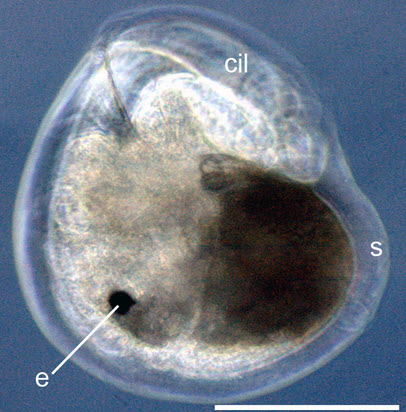
larva in metamorphosis (25% of development) of Aeolidiella stephanieae. Scale bar is 100 μm.
e = eyes
cil = cilia
s = shell.
Picture by:Alen Kristof & Annette Klussmann-Kolb
The Berghia has a rather short life cycle. Their development from egg to sexual mature adult takes a mere 60 days at 22°C / 72°F. Warmer temperatures makes them develop faster. Colder water slows down the development. The eggs hatch after about 10-14 days. Some eggs hatch as fully metamorphosed sea slugs and can start searching for food right away. Other eggs hatch in to larvae that float in the water for about 24 hours before they settle down and start their metamorphosis. The metamorphosis usually take about 48 hours and the juvenile Berghia sea slugs usually start crawling looking for food around 24 hours after the metamorphosis. They are usually actively feeding 48 hours after metamorphosis. Juvenile Berghia are usually about 600 microns long when they start feeding actively. The Berghia nudibranch can live about 10 months with a good food supply.
Keeping Berghia Sea Slugs
Berghia (Aeolidiella stephanieae) is easy to keep and care for in a reef aquarium as long as there is food, Aiptasia, to eat and the water quality is kept high and stable (<25ppm of nitrates, 0 ammonia and 0 nitrites). They will do well in most established reefs aquarium. Do not get too worried if you do not see much of your Berghia. They are small, primarily nocturnal and in some aquariums with a lot of corals and live rock you might hardly ever see any. If you want to spot them I recommend that you use a flash light to light up Aiptasia infested areas during night time. If your Sea slugs are introduced to the tank correctly you should start to see a reduction in the amount of Aiptasia in a couple of weeks.
Berghia are very small and add a very small bioload to your tank.
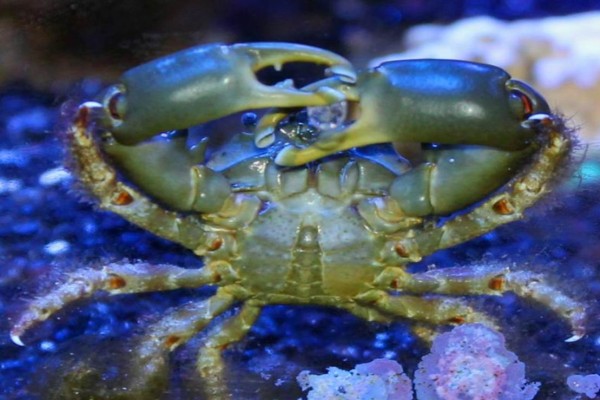 It is important to remember that just because a fish or invertebrate is reef safe it does not mean that they will not eat Berghia sea slugs. Many popular fish species do sometimes eat them including some wrasses, filefish, butterfly fish and dottybacks. This is not a complete list of fish that might eat Berghia and it is important that you keep an eye on your tank to see if your sea slugs are being left alone. There is also a lot of invertebrates that will eat them including emerald crabs, sally lightfoot crabs, arrow crabs, pom pom crabs and peppermint shrimps. Emerald crabs seldom eat Berghia if there is plenty of algae around for them to eat.
It is important to remember that just because a fish or invertebrate is reef safe it does not mean that they will not eat Berghia sea slugs. Many popular fish species do sometimes eat them including some wrasses, filefish, butterfly fish and dottybacks. This is not a complete list of fish that might eat Berghia and it is important that you keep an eye on your tank to see if your sea slugs are being left alone. There is also a lot of invertebrates that will eat them including emerald crabs, sally lightfoot crabs, arrow crabs, pom pom crabs and peppermint shrimps. Emerald crabs seldom eat Berghia if there is plenty of algae around for them to eat.
The fact that peppermint shrimp eat Berghia can be a problem since peppermint shrimp often are added to aquariums to control and eat Aiptasia in reef aquariums. They do however enjoy eating berghia and will therefore need to be removed from the tank before you add the sea slugs. Peppermint shrimps are easy to remove using a trap constructed from a PET bottle. Simple cut the top of the bottle and but it back in backwards to create a entrance that becomes more narrow as they go into the trap. Shrimps will find their way out of the trap if you give them enough time so you will need to to check on and empty the traps on a more or less hourly basis. It is not a problem if you leave it longer but it can take longer before you catch all the shrimp if you do.
It is not uncommon for the Berghia to start breeding in your tank. This is nothing that you have to worry about since most of the eggs will be eaten and the population will only grow as the Aiptasia infestation allow. The slugs will start dying of when the Aiptasia has been removed. They can live for 5-7 days once the Aiptasia has been removed.
Berghia sea slugs only eat Aiptasia. There is no point trying to feed them anything else. They get their color from the Aiptasia they eat. They absorb the pigment from the Aiptasia. If you see Berghia that are completely white than this mean that they haven’t eaten in 24 hours. This means that their either is no more Aiptasia in their tank or (in a large tank) that they cant find them. If this is the case you can help the sea slugs by moving them to the Aiptasia. Remember that they are fragile.
It is important that to remember that they will start dying of once the Aiptasia has been eradicated and that this can cause some stress on the water. If you see an ammonia spike at this point than you know that dying sea slugs are the like reason. It can for this reason be good to reintroduce your peppermint shrimps to the tank 2-3 days after you saw the last Aiptasia. Or ideally 24 hours after your Berghia turns white. (IE haven’t eaten in 24 hours) They can then eat some of the sea slugs before they die of. The Berghia die off will however normally not cause a big problem since they are very small and you should only have a small number of them.
Introducing Berghia to your tank
Berghia nudibranch can be rather sensitive when first introduced to a new aquarium and it is important that you acclimatize them well. They should be drip acclimatized for at least two hours before they are put into their new tank. Keep an eye on them during the entire acclimatization process.
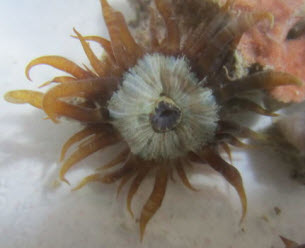
Aiptasia anemone. Picture by Smithsonian Institute.
If you acquired your Berghia Nudibranches by ordering online they might not have eaten for at least 10-14 hours (sometimes longer) when they arrive in your home. It can therefor be a good idea to feed them during the acclimatization process. Put a small part of Aiptasia in the bag.
Berghia sea slugs are very sensitive to touch and you should never try to move them into the tank by touching them. There is a great risk that you end up damaging them. The best way to move them into your tank is to use a suitable sized pipette and place them directly on the rock in the vicinity of Aiptasia so that they easily can find food.
Turn of the light and filtration system before introducing the slugs. This will give them the ideal conditions to settle in and grab hold of the live rock. It will also make it easier for them to find the Aiptasia. You can turn the light and filter back on one hour after you introduced them.
Aiptasia will eat these sea slugs if they end up in the mouth area of the Aiptasia. It is therefore very important that you make sure not to put the Berghia directly on the Aiptasia when you introduce them to the tank.
Breeding Berghia Nudibranches
Berghia Nudibranches are easy to breed if you keep them in an aquarium with good stable water quality. They will commonly breed in reef aquariums while being used for Aiptasia control. Since you are reading this text we will however assume that you want to breed Berghia on a more productive and more long term level than simply having them spawning in your main tank. The best way to achieve this is to have a tank where you only keep Aiptasia and Berghia (Aeolidiella stephanieae).
The main problem when breeding these Nudibranches is that you need a stable access to Aiptasia anemones since that is all they eat. The Berghia sea slugs are likely to eat all the Aiptasia in the breeding tank so you will need on or two other tanks for growing Aiptasia as food.
Berghia Nudibranches are hermaphroditic but are not capable of asexual reproduction. In other words they are both male and female but need to mate with another specimen to reproduce. Each Berghia will produce between 1000 to 2000 eggs per batch. Almost all eggs will be fertilized. You can read more about the development of the eggs by reading above under Berghia life cycle. It normally takes between 4-6 weeks before you can see the juvenile Berghia with the naked eye.
Using Berghia to control Aiptasia
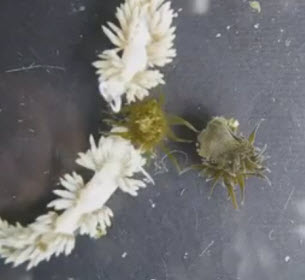
Bergia Eating Aiptasia. Watch the video
Berghia is one of the best ways of getting rid of and controlling Aiptasia in a natural way. The sea slugs will find the smallest part of Aiptasia and eat them leaving no trace of them in your tank. You do not have to worry about them growing back unless you reintroduce them into the tank somehow.
Berghia Nudibranches have evolved methods of approaching the Aiptasia that prevent the defensive mechanics of the Aiptasia to kick in. Aiptasia will not attack with their stinger cells nor release planula larva into the water when Berghia slugs approach like they do when other dangers approach. It is believed that this is caused by a the chemical composition of their mucus.
The Berghia nudibranch is able to find all Aiptasia regardless of size using organs called rhinophores and this guarantees that all Aiptasia will be eradicated. Not just larger visible specimens.
It is important to make sure that your aquarium is infested with Aiptasia and not Majano Anemones before you get Berghia. Berghia sea slugs only eat Aiptasia, they do not eat Majano. Both are common pest anemones but the Majano have shorter more stubby tentacles. The tentacles on Aiptasia is longer and more slender.
Berghia can not get into filters and other equipment. It is therefore important that you clean these areas to make sure that no Aiptasia is hiding there.
These sea slugs are not suitable to treat light infestation (less than 10 polyps) in large tanks over 30 gallons. There is a risk that the Berghia will starve before they can find all Aiptasia.
https://www.youtube.com/watch?v=5caLVzwM-1g
Why it is better to use Berghia to control Aiptasia
Aiptasia is according to me the best way of getting rid of Aiptasia. I like that it is a natural method and it avoids a lot of the problems that is associated with other methods. Some of the most important benefits with Berghia are:
- Berghia nudibranch will find all the Aiptasia in the tank. Even the ones hidden in crevices or too small for the aquarium owner to see and spot treat against.
- Chemical treatments are often sold as reef safe despite containing chemicals that are harmful to other marine life. It might not kill them but it will still disturb their biological processes. For this reason I prefer not to use any chemicals in my aquariums if not absolutely necessary. In the case of Aiptasia it is not because there is a better biological solution.
- Chemical treatments causes the Aiptasia to die more or less all at once. This causes a lot of stress on the water. When you spot treat you can to a degree lessen this problem by treating different patches of Aiptasia at different times but you still get an entire patch dieing all at once and polluting the water. Using Berghia you do not get the water pollution problems since the Aiptasia is slowly consumed over a couple of months.
- When the Aiptasia is gone you know it is gone. The sea slugs will not miss any Aiptasia and you do not have to worry about it growing back.
How many do I need
How many Berghia snails you need to control and eradicate the Aiptasia in you tank depends on how severe the infestation is. You should usually have 8-10 slugs per 100 gallons of water but if you have very severe infestation (more than 100 Aiptasia per 100 gallon) you might want to consider a higher number of snails.
How long does it take
Berghia snails is not a quick solution to Aiptasia control. It is however a natural method that will be able to remove all Aiptasia. The ones you see and the ones you do not see. It usually take a couple of weeks before you start seeing a noticeable difference. In 2-3 months the tank should be completely free of the infestation. Berghia is a great way of getting rid of Aiptasia without having to use chemicals.
References:
Valdés A. (2005). “A new species of Aeolidiella Bergh, 1867 (Mollusca: Nudibranchia: Aeolidiidae) from the Florida Keys, USA”. Veliger 47(3): 218-223.
Felder, D.L. and D.K. Camp (eds.), Gulf of Mexico–Origins, Waters, and Biota. Biodiversity. Texas A&M Press, College Station, Texas.
WoRMS (2013). Aeolidiella stephanieae Valdés, 2005. Accessed through: Tunnel, W.; Moretzsohn, F. (2013) Gulf of Mexico register of marine species at http://www.marinespecies.org/aphia.php?p=taxdetails&id=389717

Interesting Blog Articles
I though I would share a few articles I got something out of this past week
Some Refugium information
http://blog.aquanerd.com/2009/09/can-refugiums-be-bad-thing.html
Hang on back skimmers
http://blog.aquanerd.com/2009/09/atb-hang-on-tank-skimmer-in-action.html
Bristle Worms
http://www.thereeftank.com/blog/what-to-do-with-bristle-worms/

Some Tips for Beginners
The below is some key learnings that I had stumbled upon in my never ending journey of learning and keeping marine aquariums. I thought I would take the time to share them.
Continue reading
Lightning clownfish fry
It is a big day for all clownfish lovers and especially those who hope to keep a lightning clownfish sometimes in the future. Not too long ago we reported on what ultimately turned out to be a failed spawning of the Lightning clownfish. Well a few days ago the pair spawned again and this time they didn’t eat their eggs. A few hours ago the first eggs hatched and the remaining ones where moved to a dedicated Black Round Tub for artificial hatching. There are still some challenges before we get to see lightning clownfish fry and there is no guarantee that the pair will produce Lightning clownfish fry but with a little bit of luck we will see lightning patterned fry before we know it that can be passed on to other breeders that can help this wonderful type of PNG clownfish spread in the hobby.
Go to lightning-maroon-clownfish.com/ for the latest news about the fry and the breeding efforts. You can see the hatching announcement here.
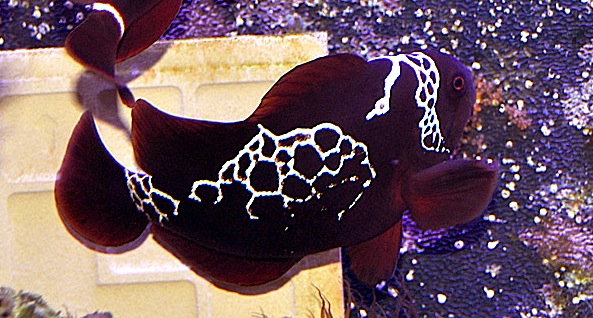
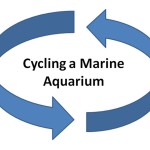
Cycling a Marine Aquarium
I just thought I would take some time to explain some of the methods that can be used to cycle a marine aquarium in a little more detail that what we currently have on our forum. The nitrogen cycle in a marine environment is similar to that of the nitrogen cycle in a fresh water environment. In both environments you have nitrifying bacteria that coverts ammonia into nitrites and nitrites into nitrates. While the nitrifying bacteria in a marine aquarium are different bacteria then the nitrifying bacteria in a fresh water tank, they do perform the same functions and essentially work the same. A marine nitrogen cycle has the addition of de nitrifying bacteria which converts nitrates into nitrogen gas. I will be making many comparisons between the fresh water and salt water cycling methods through this article in order to better illustrate some points better for people who are new to salt water aquariums.
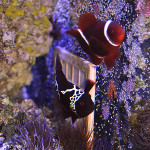
The lightning maroon clownfish finally spawned!!!
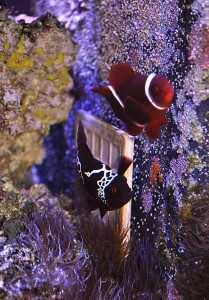
By: Matt Pedersen
Yes you read right. Matt Pedersen little “doubling down“ trick to get them to spawn that we wrote about here seems to have worked and the lightning maroon clownfish has finally spawned after 2 years of trying. This is very good news for all those who hope to keep these stunning fish one day, myself included.
Matt has been trying to get them to breed for two years now pairing it with a number of other maroon clownfish of both sexes. Finally it paired with a smaller maroon clownfish and this morning matt could finally report that they had spawned for the first time. (read the full story here.) It is a bit early to get too excited since it is common for the first spawns to fail and to produce where few fertile eggs but once a clownfish pair start to spawn they usually continue doing so. Matt should hopefully soon have a number of lightning clowns to breed from and pass on to other successfully breeders so that they can help this clown fish become more available. This clownfish really deserves to become a common sight in aquariums around the worlds and the chances of that happening greatly increased today.
Until today only two lightning maroon clownfish was ever caught, both in the waters of Papua New Guinea. Just a few weeks ago a third fish was caught in the same waters that resembles the lightning maroons but with a much less distinct pattern. See the image below. This latest catch was aquired by EcoReef UK
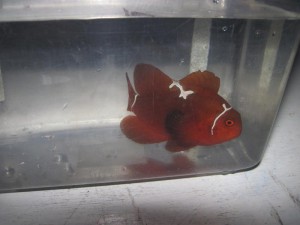
Lightning Maroon Clownfish
The lightning Maroon Clownfish is a one of a kind truly stunning clown fish that was caught of Papua New Guinea. One of a kind fish like this usually go to people willing to pay biiiig money for them but in this case Blue Zoo Aquatics opted to make sure that it went to an established breeder instead to make sure that we all might get to enjoy these stunning color morph in the future. It would not be the first time a new color morph has been developed form a single original fish.
Although the lightning Maroon Clownfish paired of last year (2011) the pair has so far not laid any eggs or produced any offspring.
Pairing video:
The breeder has now decided to try to use a technique called “Double down” in which you move a batch of eggs another couple laid to the couple you want to start breeding. The idea is that either the fish start caring for the eggs that are given to them, which usually triggers them to start laying their own egg before long, or they eat the eggs that are given to them and get a very nutritious meal. In this case, the eggs, taken from an Onyx Percula spawning, were received somewhat well and the pair is showing signs of caring for the eggs which might be a good sign and hopefully we will get to see baby lightning Maroon Clownfish before long. If you want more info or keep up to date with the attempts to spawn the lightning Maroon Clown fish you can visit the lightning project website and if you want more info on this particular breeding attempt you can click here.
The lightning Maroon Clownfish guarding the new eggs:
Coral Diseases
Background
This is a very difficult topic to learn about, as for the most part, not enough scientific study has been completed yet. Coral disease research really did not get a lot of focus until the mid 1970s with many of the common diseases only becoming properly identified in the early 1990s. With the increasing levels of pollutants in the waters of the coral reefs, combined with the effects of global warming, more and more diseases have be developing, along with the frequency they are being found in among the ocean’s coral reefs.
This is (IMO) a very serious threat to the long-term health of our coral reefs today. For example, White band disease has had a devastating impact in the coral reefs in the Florida Keys (killing ~95% of all Acropora SPS corals), and in the Caribbean (infecting ~50% of the shallow water, mostly Elkhorn SPS corals within the first five years after this disease was discovered there). During the past 10 years, the Caribbean coral reefs are being affected more and more each year. New diseases have even started to surface that affect coralline algae (Coralline Lethal Algae Disease) which could also have a significant impact on health of our coral reefs.
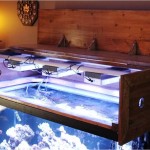
Reef Lighting
This article was written by myself and Cliff. The first part was written by me (Dave66), and Cliff gives an overview of LED (Light Emitting Diode) lighting.
—-
Perhaps the most important and vital piece of equipment one can buy for their reef aquarium is lighting.
Fully 95 percent of corals available in shops and online are photosynthetic. That is, they have photosynthetic bacteria in their tissues (zooxanthellae). The bacteria ‘feed’ on the light, and the sugars they produce as waste feeds the coral.
On the tropical reef it’s the sun that powers the photosynthesis of zooxanthellae. In the aquarium, it is the responsibility of the keeper to simulate the sun in their aquariums. Lighting is one of the major costs in starting a reef tank. Continue reading